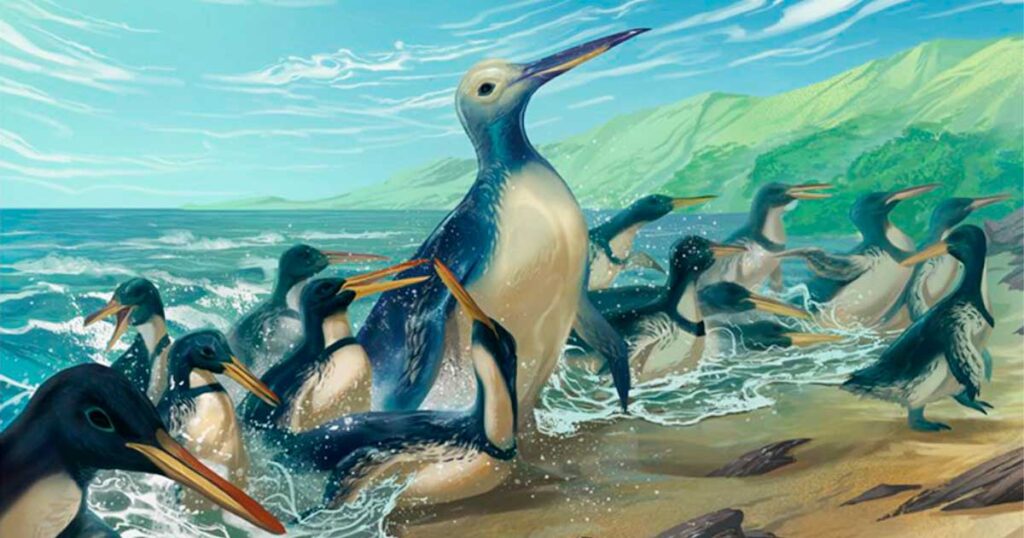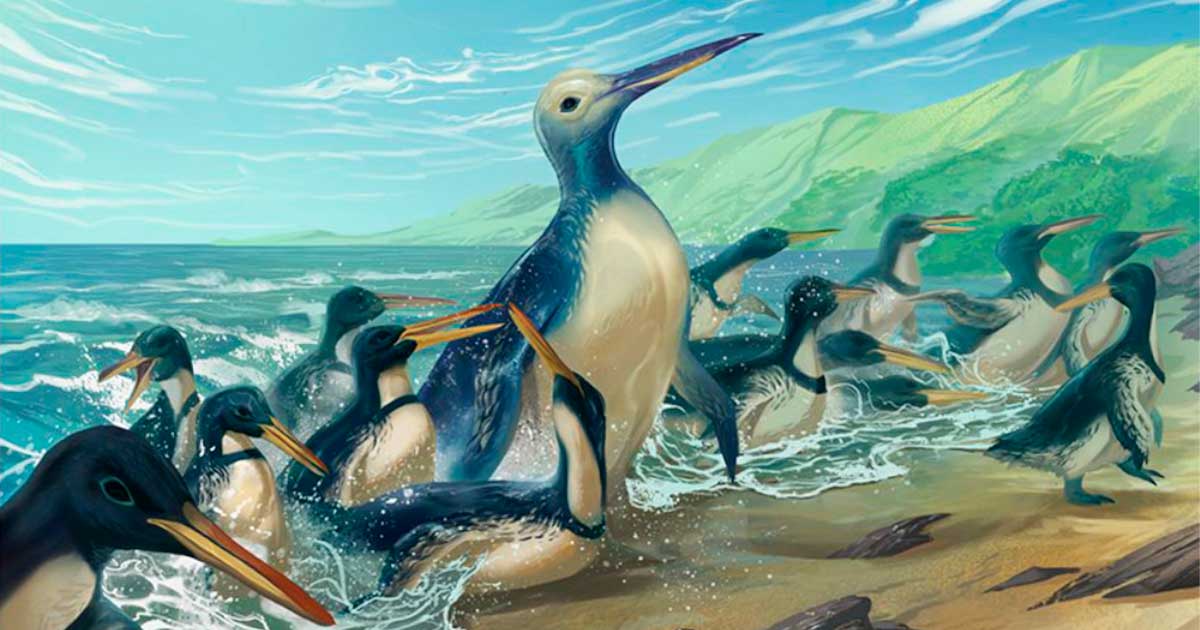

Scientists have discovered what appears to be the world’s biggest penguin species known to have swum Earth’s oceans or waddled across its surface, and it was the size of a gorilla! This newly revealed species — dubbed Kumimanu fordycei by its discoverers — lived in the Paleocene Epoch approximately 57 million years ago in what is now New Zealand.
In an article recently published in the prestigious Journal of Paleontology, researchers reported that the fossilized remains of the world’s biggest penguin were discovered embedded in a boulder lying near a beach in the North Otago region of New Zealand’s South Island. “According to our analysis K. fordycei is the biggest penguin currently known,” study lead author Daniel Ksepka a paleontologist and curator at the Bruce Museum in Greenwich, Connecticut, confirmed in an interview with Live Science.

Skeletal illustrations of Kumimanu fordycei, Petradyptes stonehousei, and a modern emperor penguin showing the sizes of the new fossil species. (Simone Giovanardi)
Monster Birds Have a New Member: The World’s Biggest Penguin
Based on careful skeletal analysis, the researchers concluded that an adult K. fordycei would have weighed in the neighborhood of 340 pounds (154 kg), which makes this penguin about 25 to 30 percent heavier than any other penguin known to have existed. While the fossilized skeleton of the world’s biggest penguin didn’t allow for measurements that would determine exact height, projecting from the creature’s weight alone suggests this biggest of all big swimming birds might have stood as much as eight feet (2.5 meters) tall when standing on land.
Up to now, the tallest penguin known to have existed was Palaeeudyptes klekowskii (the so-called “colossus penguin”), which lived on the continent of Antarctica 37 million years ago and grew to a height of six-foot-six (two meters) at full maturity. The heaviest of all previously discovered penguins was Kumimanu biceae, which could reach weights of up to 267 pounds (121 kg) when healthy and well-fed (despite its bulk this species was a few inches shorter than P. klekowskii).
Interestingly, the latter penguin and the newly discovered bird both belonged to the same ancient genus, Kumimanu. This name was created by combining the Maori indigenous culture’s words for mythological monster and bird, which are kumi and manu respectively.
From the perspective of the modern observer, the term “monster bird” certainly fits for this genus. The largest known penguin living today is the Emperor penguin, which checks in at a maximum of just under four feet (1.2 m) tall and weighs in at no more than 88 pounds (40 kg).
For now, K. fordycei holds the title for the world’s biggest penguin of ancient times, remembered as monster birds that wandered the shorelines of prehistoric New Zealand. But how long it will retain its designation remains to be seen. “The size of K. fordycei doesn’t necessarily mean there wasn’t an even larger species that is yet to be discovered,” Ksepka said, speaking for paleontologists everywhere who are constantly searching for the new and the amazing.

The largest known penguin living today is the Emperor penguin, at a maximum of about four feet (1.2 m) tall, as compared to K. fordycei, the newly discovered world’s biggest penguin. (neydornelas / Adobe Stock)
Why Were Paleocene Penguins So Darn Big?
During the Paleocene Epoch, which lasted from 66 million to 56 million years ago, the lands of Antarctica and New Zealand were populated with several humungous species of penguin. This has been confirmed in recent years by a feast of giant penguin fossil findings, primarily in the much more accessible islands of New Zealand.
The arrival of the enormous K. fordycei proves that gigantism must have offered clear survival advantages in those far-distant times, at least for birds that swam but didn’t fly and needed to catch a lot of fish to avoid starvation.
“It goes to show that the advantages of large size, such as more efficient thermoregulation and diving, probably exerted very strong selective pressure on penguins soon after they lost flight,” Ksepka said. Penguins lost the capacity to fly approximately 60 million years ago, perhaps because they were adapting to the ocean ecosystem and didn’t need that ability as much as birds living elsewhere.
The unique ecological conditions of prehistoric New Zealand undoubtedly helped shape the evolution of the earliest penguins, the scientists involved in the new study concluded. “New Zealand is (and has been) a great place to be a penguin,” Ksepka noted. “There are good feeding grounds offshore for marine birds, and there were no land mammals other than bats in New Zealand before humans arrived, which makes for safer nesting areas.”
Penguins thrived in ancient New Zealand and as a result of their success there was nothing to stop them from getting bigger and bigger. The giant penguins went extinct around 27 million years ago. While there is no definitive explanation as to why, the most likely answer is that they were outcompeted for food by large marine mammals (like whales) that eventually moved into the area.
When the World’s Biggest Penguins Were as Big as Polar Bears
The fossils of Kumimanu fordycei were first spotted in 2017, encased in rock near a South Island beach, along with fossils from eight other similar specimens. Five of these belonged to another newly discovered giant penguin species, Petradyptes stonehousei, while one was a specimen of K. biceae and the other two are currently unidentified.
The rocks from the different boulders that held these remarkable fossils were all dated to Paleocene times, ranging in age from 59.5 million to 55.5 million years old. Following up on this astonishing discovery of the world’s biggest penguin from the ancient world, the paleontologists used laser scanners to create digital models from the exposed fossilized bones. They then compared the models to bones from other fossilized ancient species, and to the bones of modern penguins as well.
Thanks to these digital models, the team was able to prove they’d discovered two new extinct species of penguins, both of which were much larger than modern-day penguins. To calculate the size of the newly discovered penguin species, the scientists measured hundreds of modern penguin bones, for the purpose of comparison. They focused on the dimensions of the flipper bone in particular, since this would allow them to estimate how much the ancient penguins weighed.
The other newly discovered penguin species, Petradyptes stonehousei, was found to have had similar dimensions to other types of giant penguins. But the huge and powerfully built flipper bones of K. fordycei were of a different size and dimension than the rest, showing that they belonged to a species that was noticeably larger than any of its cousins.
“Fossils provide us with evidence of the history of life, and sometimes that evidence is truly surprising,” study co-author Dr. Daniel Field, a paleontologist from the University of Cambridge, told the Independent when discussing the find of the world’s biggest penguin. In the future, if paleontologists prowling the ancient breeding grounds of giant penguins stumble upon a species that is even larger than the massive K. fordycei, their level of surprise (and delight) could shoot into the stratosphere.